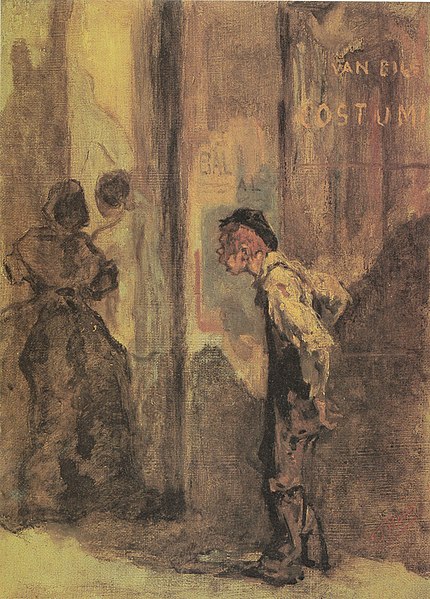Félicien Victor Joseph Rops was a Belgian artist associated with Symbolism, Decadence, and the Parisian fin de siècle. He was a painter, illustrator, caricaturist and a prolific and innovative print maker, particularly in intaglio. Although not well known to the general public, Rops was greatly respected by his peers and actively pursued and celebrated as an illustrator by the publishers, authors, and poets of his time. He provided frontispieces and illustrations for works by Jules Barbey d'Aurevilly, Charles Baudelaire, Charles De Coster, Théophile Gautier, Joris-Karl Huysmans, Stéphane Mallarmé, Joséphin Péladan, Paul Verlaine, Voltaire, and many others. Best known today for his prints and drawings illustrating erotic and occult literature of the period, he also produced oil paintings including landscapes, seascapes, and occasional genre paintings. Rops is recognized as a pioneer of Belgian comics.
Detail from The Members of the Société Libre des Beaux-Arts by Edmond Lambrichs
Felicien Rops in his Studio by Paul Mathey
A Self-Portrait in crayon and ink from the 1860s (detail)
Entrance to the Ball (ca. 1858) Oil on canvas, mounted on board (29.5 x 21 cm) Musée Félicien Rops, Namur, Belgium
Symbolism was a late 19th-century art movement of French and Belgian origin in poetry and other arts seeking to represent absolute truths symbolically through language and metaphorical images, mainly as a reaction against naturalism and realism.
Death and the Grave Digger (La Mort et le Fossoyeur) (c. 1895) by Carlos Schwabe is a visual compendium of symbolist motifs. The angel of Death, pristine snow, and the dramatic poses of the characters all express symbolist longings for transfiguration "anywhere, out of the world".
Henri Fantin-Latour, By the Table, 1872, depicting: Paul Verlaine, Arthur Rimbaud, Léon Valade, Ernest d'Hervilly and Camille Pelletan (seated); Pierre Elzéar, Emile Blémont, and Jean Aicard (standing)
Portrait of Charles Baudelaire (c. 1862), whose writing was a precursor of the symbolist style
Eugen Bracht, The Shore of Oblivion, 1889








